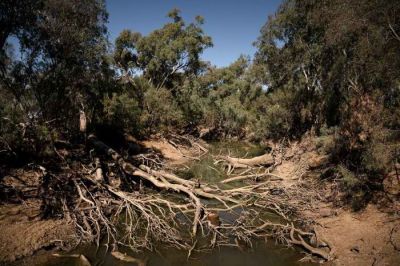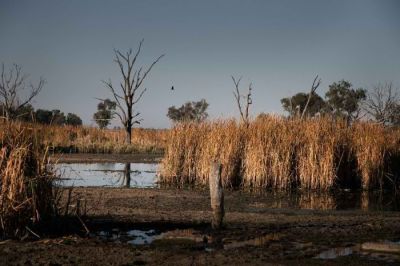Irrigators in New South Wales are set to receive vast new licences to take water from the Murray-Darling Basin, handed out for free under a state proposal that some say will undermine the national $13 billion plan to save the country’s most important river system.
Upstream irrigators who would receive lucrative licences have broadly welcomed the plan, but ecologists say it could doom some of the country’s most important wetlands.
Environmental lawyers say the policy might be illegal and downstream graziers complain it will make irrigators rich at their expense.
Emma Carmody, a lawyer at the Environmental Defenders Office of NSW, said the policy is likely not allowed under the federal Water Act, and is the latest in a number of policies that she says could be illegal.
“I’m very alarmed because what it suggests to me is a disregard bordering on contempt for the rule of law,” she said.
Taking water out of rivers in the basin requires a licence, but currently, when that water spills out over land during floods in NSW, it has been free for the taking.
Irrigators have been allowed to build vast earthworks to funnel flood water into enormous dams without requiring licenses, or even any measurement.
Michael Egan, a cotton grower from the Macquarie Valley in the state’s central west, said he and other irrigators had used unlicensed flood water to avoid depleting their licensed allocation.
“It’s been going on ever since we’ve been irrigating,” Mr Egan said.
He is also the chairman of Macquarie Food and Fibre, which represents irrigators in the region.
Bill Johnson, a water ecologist who used to manage environmental water for the federal Murray-Darling Basin Authority, said the only limit to how much flood water irrigators in NSW could take was the size of their pumps and their dams.
“I think there has been a free-for-all when it comes to floodplain harvesting,” he said.
Those currently taking most will get biggest licensed share
Plans to regulate that water have been in the works since 2008, when it was floated by the Nathan
They are also now calculating how much each valley — and each irrigator — will be licensed to harvest from floodplains.
Their proposal is to hand out free licences to formalise however much irrigators have taken in the past. That means whoever managed to take the most will receive the biggest share of licences.
Those that get the new licences will be allowed to sell them to others and if there are changes to the regime, irrigators would need to be compensated for any reduction in entitlements.
The current estimates of how much water will be handed out have not yet been made public.
The plan is to give irrigators license to extract as much water as they were capable of extracting and storing in 2000, assuming an average amount of rainfall.
Those figures will be determined by how much water storage irrigators have built in each valley — something the Government has released estimates of.
Those estimates show the amount of water that could be licensed is vast.
In the Gwydir Valley alone, the Government estimates there is currently more than 600 gigalitres of water storage — that is more than all the water in Sydney Harbour.
Mr Johnson said everyone downstream — all the way through South Australia and Victoria — should be worried about the amount of water that will be handed out.
“The effect of this will be the water in the Northern Basin will cease to follow down the Barwon Darling and into the Murray system,” he said.
“It won’t flow to South Australia. It will result in practically in a separation of the two systems and flows will only get down the Murray-Darling in the very biggest of the floods.”
Mr Egan insisted floodplain harvesting had no impact on the environment or downstream users.
“When there’s a lot of water around, there’s a lot of water around for everybody,” he said.
“And the floodplain harvesting just doesn’t affect that whatsoever.”
But Richard Kingsford, a water ecologist from the University of New South Wales, said taking flood water had big environmental impacts.
He said doing so shrinks the size of the floods.
“It’s only in really big floods that … Coolabah and Black Box Forest get water and once you start denying that, they will start to die,” he said.
The plan is not intended to allow any more water to be extracted than is currently — something NSW Water Minister Niall Blair and irrigators both emphasise.
“Look, this is not extra water. This is just putting a structure and framework around activities that are occurring now,” Mr Blair said.
“It also allows more transparency.”
But critics argue that since there has been no transparency over how much water is currently being taken, the Government has no ability to know when irrigators exceed that amount into the future.
The volumes of water taken from floodplains in NSW have not been measured.
Mr Kingsford said that meant irrigators might be able to get licences that allow them to take more than they have ever actually taken before.
“My big criticism of this whole business is that we’re using essentially a finger in the air, and saying, ‘well let’s guess it was this’ and allowing the potential for people to develop much more than they would have historically,” he said.
Even if the policy does achieve its aim and limit extraction to 2000 levels, Mr Kingsford says that is not a sustainable level of take.
“We’re talking about large amounts of water being extracted out of these systems and denied from the floodplains downstream,” he said.
“So we’re talking about a cumulative impact on each of these river systems right down to the bottom of the Murray-Darling Basin.”
Policy is potentially ‘legal nonsense’
If the amount of water allowed to be taken by the policy is not sustainable, then the policy would be illegal, contravening the federal Water Act, according to Ms Carmody.
“Based on my understanding, it is unlikely to be consistent with the core requirements of the Water Act,” she said.
The NSW Department of Industry and the federal Murray-Darling Basin Authority both told the ABC the new licences handed out would need to be added to “baseline” extraction totals.
That means it would be added to the amount of water authorities assumed was being extracted from the basin when the Murray-Darling plan was established.
In other words, they would end up recalibrating how much water they estimated could be sustainably taken from the system to incorporate all the floodplain harvesting that has been occurring.
“Well to me, that is a hydrological and environmental and a legal nonsense,” Ms Carmody said.
“The method by which they are proposing to incorporate it within the basin plan framework — I simply cannot see how it could be consistent with all the requirements of the Water Act.”
She said if more water was being taken from the system than was previously assumed, then more needed to be recovered too.











